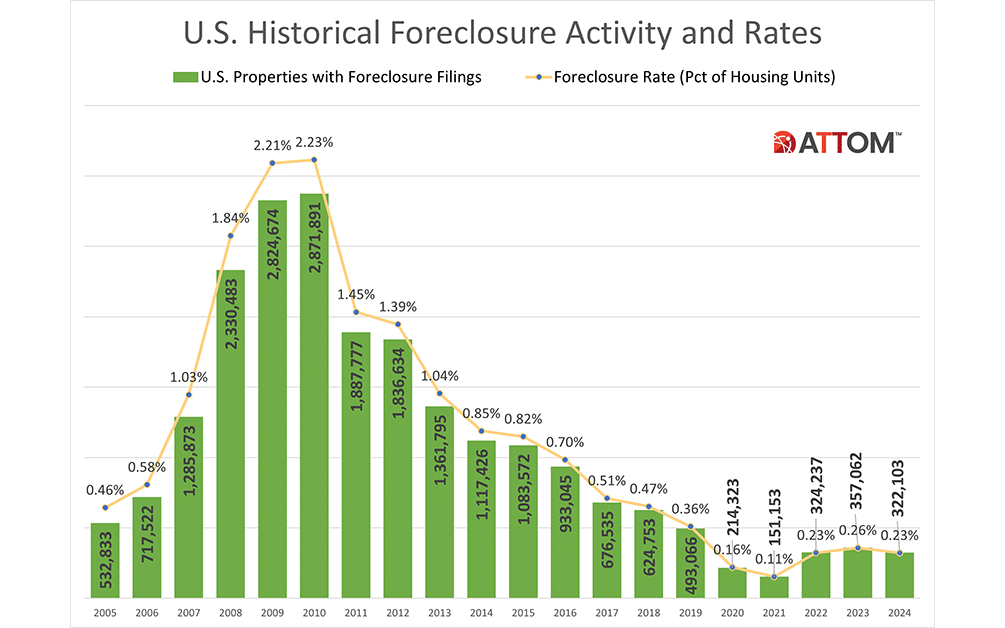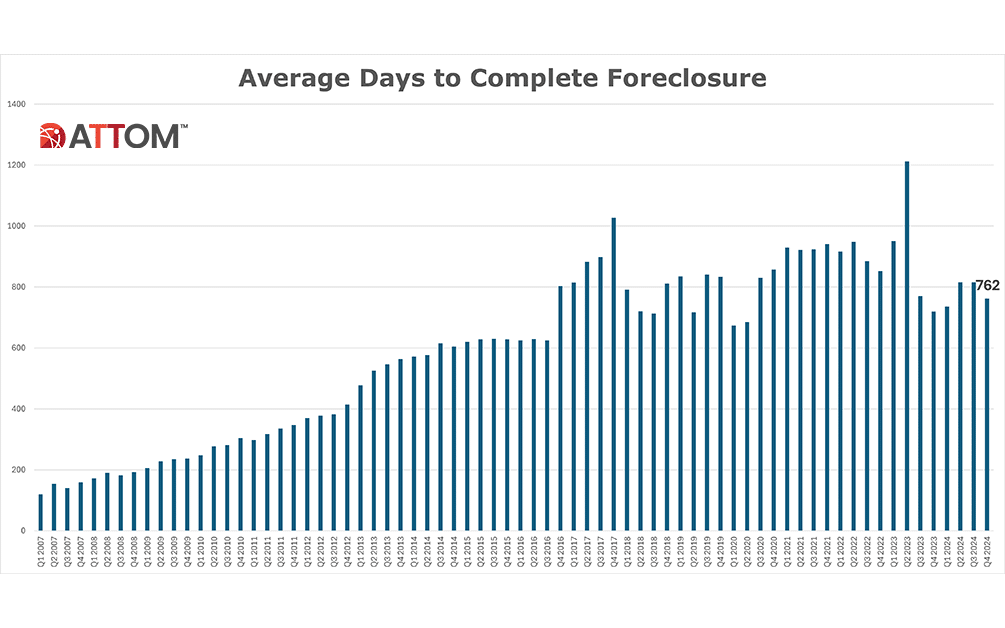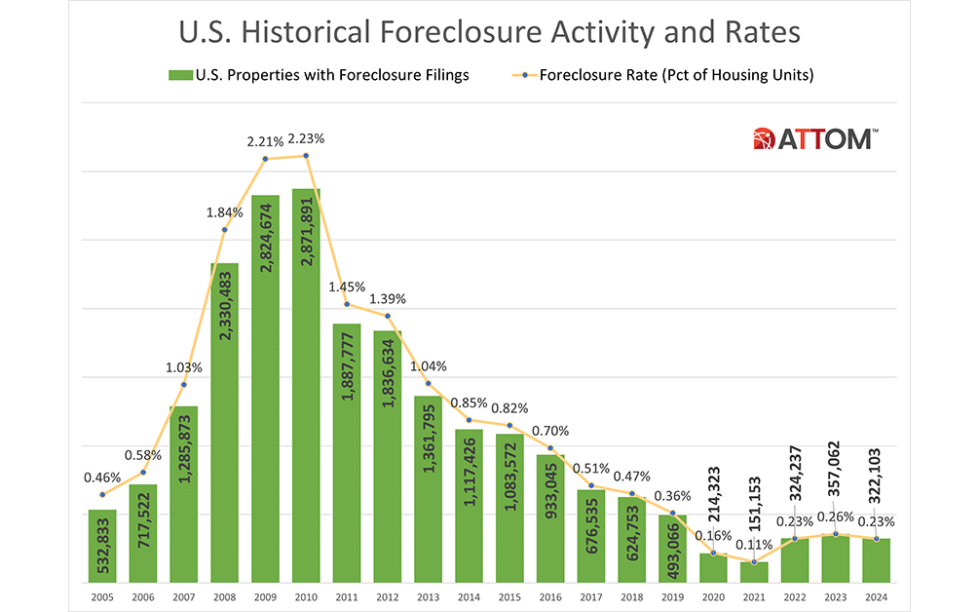Foreclosure Starts and Completions Down from 2023; December 2024 Foreclosure Activity Declines from Previous Month and Year; Q4 2024 Foreclosure Activity Declines from Previous Quarter and Year
IRVINE, Calif. – Jan. 16, 2025 — ATTOM, a leading curator of land, property data, and real estate analytics, today released its Year-End 2024 U.S. Foreclosure Market Report, which shows foreclosure filings— default notices, scheduled auctions and bank repossessions — were reported on 322,103 U.S. properties in 2024, down 10 percent from 2023 and down 1 percent from 2022 and down 35 percent from 2019, before the pandemic shook up the market. Foreclosure filings in 2024 were also down 89 percent from a peak of nearly 2.9 million in 2010.
Those 322,103 properties with foreclosure filings in 2024 represented 0.23 percent of all U.S. housing units, down slightly from 0.25 percent in 2023, and down from 0.36 percent in 2019 and down from a peak of 2.23 percent in 2010.
“The continued decline in foreclosure activity throughout 2024 suggests a housing market that may be stabilizing, even as economic uncertainties persist,” said Rob Barber, CEO at ATTOM. “This year’s data points to foreclosure trends potentially returning to more predictable levels, offering some clarity for industry professionals, investors, and homeowners. While foreclosure filings remain a critical metric for understanding market health, current trends may point to a more balanced landscape, potentially shaped by careful lending practices and ongoing homeowner resilience.”

ATTOM’s year-end foreclosure report provides a unique count of properties with a foreclosure filing during the year based on publicly recorded and published foreclosure filings collected in more than 3,000 counties nationwide, accounting for more than 99 percent of the U.S. population – also available for licensing or customized reporting. See full methodology below.
The report also includes new data for December 2024, showing there were 28,632 U.S. properties with foreclosure filings, down 3 percent from the previous month and down 6 percent from a year ago.
Foreclosure starts on the decline nationwide
Lenders started the foreclosure process on 253,306 U.S. properties in 2024, down 6 percent from 2023, up 174 percent from 2021, but down 25 percent form 2019 and down 88 percent from a peak of 2,139,005 in 2009.
States that saw the greatest number of foreclosure starts in 2024 included California (29,529 foreclosure starts); Florida (29,239 foreclosure starts); Texas (28,946 foreclosure starts); New York (14,436 foreclosure starts); and Illinois (13,082 foreclosure starts).
Those metropolitan statistical areas with a population greater than 1 million that saw the greatest number of foreclosure starts in 2024, included New York, New York (15,327 foreclosure starts); Chicago, Illinois (11,508 foreclosure starts); Houston, Texas (10,197 foreclosure starts); Los Angeles, California (8,790 foreclosure starts); and Miami, FL (8,603 foreclosure starts).
Bank repossessions continue second year of decline
Lenders repossessed 36,505 properties through foreclosures (REO) in 2024, down 13 percent from 2023 and down 75 percent from 2019 (143,955) and down 97 percent from a peak of 1,050,500 in 2010.
States that saw the greatest number of REOs in 2024 included California (3,466 REOs); Illinois (2,858 REOs); Pennsylvania (2,828 REOs); Michigan (2,629 REOs); and Texas (2,501 REOs).
Those metropolitan statistical areas with a population greater than 1 million that saw the greatest number of REOs in 2024 included Chicago, IL (1,976 REOs); New York, New York (1,815 REOs); Detroit, Michigan (1,575 REOs); Philadelphia, Pennsylvania (946 REOs); and Baltimore, Maryland (905 REOs).
Florida, New Jersey, and Nevada post highest state foreclosure rates in 2024
States with the highest foreclosure rates in 2024 were Florida (1 in ever 267 housing units with a foreclosure filing); New Jersey (1 in every 267 housing units); Nevada (1 in every 273 housing units); Illinois (1 in every 278 housing units); and South Carolina (1 in every 304 housing units).
Rounding out the top 10 states with the highest foreclosure rates in 2024, were Connecticut (1 in every 306 housing units); Maryland (1 in every 322 housing units); Ohio (1 in every 325 housing units); Indiana (1 in every 328 housing units); and Delaware (1 in every 329 housing units).
Lakeland, Atlantic City, and Columbia post highest metro foreclosure rates in 2024
Among 224 metropolitan statistical areas with a population of at least 200,000, those with the highest foreclosure rates in 2024 were Lakeland, FL (1 in every 172 housing units with a foreclosure filing); Atlantic City, New Jersey (1 in every 200 housing units); Columbia, SC (1 in every 204 housing units); Cleveland, OH (1 in every 208 housing units); and Las Vegas, NV (1 in every 231 housing units).
Metro areas with a population greater than 1 million, including Cleveland, Ohio and Las Vegas, Nevada that had the highest foreclosure rates in 2024 were: Orlando, Florida (1 in every 234 housing units); Jacksonville, Florida (1 in every 241 housing units); Chicago, Illinois (1 in every 245 housing units); and Miami, Florida (1 in every 247 housing units).
Average time to foreclose decreases quarterly but increases annually
U.S. properties foreclosed in the fourth quarter of 2024 had been in the foreclosure process an average of 762 days, a 6 percent decrease from the previous quarter but a 6 percent increase from a year ago.


States with the longest average time to foreclose in Q4 2024 were Louisiana (3,015 days); Hawaii (2,505 days); New York (2,099 days); Wisconsin (1,989 days); and Nevada (1,750 days).
Q4 2024 Foreclosure Activity High-Level Takeaways
- There was a total of 84,361 U.S. properties with foreclosure filings in Q4 2024, down 3 percent from the previous quarter and down 9 percent from a year ago.
- Nationwide in Q4 2024, one in every 1,671 properties had a foreclosure filing.
- States with the highest foreclosure rates in Q4 2023 were Nevada (one in every 1,003 housing units with a foreclosure filing); Florida (one in every 1,110 housing units); New Jersey (one in every 1,127 housing units); Indiana (one in every 1,141 housing units); and Connecticut (one in every 1,222 housing units).
December 2024 Foreclosure Activity High-Level Takeaways
- Nationwide in December 2024, one in every 4,922 properties had a foreclosure filing.
- States with the highest foreclosure rates in December 2024 were Nevada (one in every 2,707 housing units with a foreclosure filing); Indiana (one in every 2,833 housing units); Maryland (one in every 3,253 housing units); Utah (one in every 3,257 housing units); and New Jersey (one in every 3,275 housing units).
- 19,376 U.S. properties started the foreclosure process in December 2024, down 4 percent from the previous month and down 5 percent from a year ago.
- Lenders completed the foreclosure process on 2,957 U.S. properties in December 2024, down 4 percent from the previous month and down 16 percent from a year ago.
Report methodology
The ATTOM U.S. Foreclosure Market Report provides a count of the total number of properties with at least one foreclosure filing entered into the ATTOM Data Warehouse during the month and quarter. Some foreclosure filings entered into the database during the quarter may have been recorded in the previous quarter. Data is collected from more than 3,000 counties nationwide, and those counties account for more than 99 percent of the U.S. population. ATTOM’s report incorporates documents filed in all three phases of foreclosure: Default — Notice of Default (NOD) and Lis Pendens (LIS); Auction — Notice of Trustee Sale and Notice of Foreclosure Sale (NTS and NFS); and Real Estate Owned, or REO properties (that have been foreclosed on and repurchased by a bank). For the annual, midyear and quarterly reports, if more than one type of foreclosure document is received for a property during the timeframe, only the most recent filing is counted in the report. The annual, midyear, quarterly and monthly reports all check if the same type of document was filed against a property previously. If so, and if that previous filing occurred within the estimated foreclosure timeframe for the state where the property is located, the report does not count the property in the current year, quarter or month.
About ATTOM
ATTOM provides premium property data and analytics that power a myriad of solutions that improve transparency, innovation, digitization and efficiency in a data-driven economy. ATTOM multi-sources property tax, deed, mortgage, foreclosure, environmental risk, natural hazard, and neighborhood data for more than 155 million U.S. residential and commercial properties covering 99 percent of the nation’s population. A rigorous data management process involving more than 20 steps validates, standardizes, and enhances the real estate data collected by ATTOM, assigning each property record with a persistent, unique ID — the ATTOM ID. The 30TB ATTOM Data Warehouse fuels innovation in many industries including mortgage, real estate, insurance, marketing, government and more through flexible data delivery solutions that include ATTOM Cloud, bulk file licenses, property data APIs, real estate market trends, property navigator and more. Also, introducing our newest innovative solution, making property data more readily accessible and optimized for AI applications – AI-Ready Solutions.
Media Contact:
Megan Hunt
megan.hunt@attomdata.com
Data and Report Licensing:
datareports@attomdata.com
Written by: ATTOM Team

